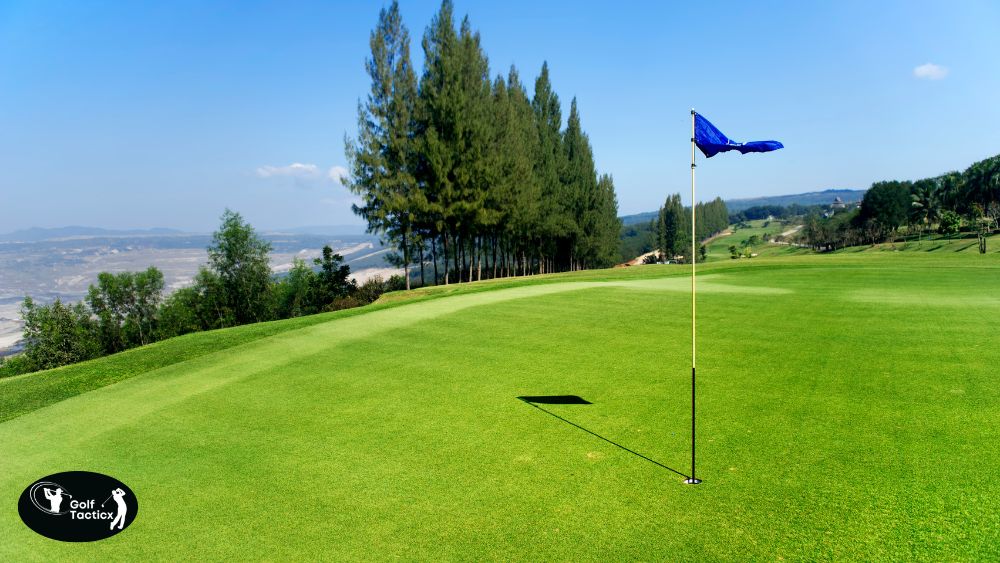In the previous post, we talked about the best way to develop a consistent putting stroke in golf, focusing on technique and tips to improve your overall performance on the green.
Knowing how to accurately assess green speed and slope in golf can really improve your putting game. It helps you read the green better, choose the right direction, and control how hard you hit the ball. Many golfers struggle with this, but with a few simple tips, you can get much better at it.
In this guide, we’ll explain how to accurately assess green speed and slope in golf using easy steps that work for all skill levels. Also, wearing the best golf shoes gives you better balance and feel, which is key for reading greens with confidence.
Assessing Green Speed
Green speed refers to how fast the ball rolls on the putting surface. A commonly used method to measure this is the Stimpmeter, a device that measures the distance a ball rolls after being released from a specific height. While this tool is primarily used by course superintendents, understanding its readings can help you gauge green speed during your round.
Using the Stimpmeter
Setup: Place the Stimpmeter on a level part of the green.
Release: Raise the end of the Stimpmeter to a specific angle, allowing the ball to roll down the track and onto the green.
Measure: The distance the ball travels on the green indicates the green speed.
For a detailed guide on using the Stimpmeter, refer to the USGA’s instructions.
Assessing Green Slope
Green slope refers to the incline or decline of the putting surface, affecting how the ball breaks during a putt. Accurately reading the slope is crucial for judging the break and speed of your putts.
Methods to Assess Slope
Visual Inspection
Walk the Green: Before your round, walk around the green to observe its contours.
Look for High and Low Points: Identify areas where the green rises or falls, which will influence the ball’s path.
Use the Plumb-Bob Method
How to Use: Hold your putter vertically by the grip, allowing the head to dangle. Align the shaft with your target line and observe how the putter head hangs. If it points to the left, the green slopes left; if it points to the right, the green slopes right.
Observe Water Flow
After Rain: Look for areas where water accumulates or drains, indicating the slope direction.
Practical Tips:
Practice Reading Greens: Spend time practicing on different greens to develop your ability to read slopes and speeds accurately.
Use Technology: Consider using golf apps that provide green maps and slope information to assist in your assessments.
For a visual demonstration on measuring green speed, you might find this video helpful:
What Are the Best Techniques for Reading Grain on the Greens?
Understanding and reading the grain of the green is crucial for accurate putting. The grain refers to the direction in which the grass blades grow, influencing how the ball rolls. Let’s explore effective techniques to read the grain and enhance your putting accuracy.
Understanding Grain on the Green
The grain of the green affects the ball’s speed and break:
Down Grain: When the grass grows in the direction of the putt, the ball rolls faster.
Into Grain: When the grass grows against the direction of the putt, the ball rolls slower.
Across Grain: When the grass grows perpendicular to the putt, the ball’s speed can vary based on the grass type and moisture.
Techniques to Read the Grain
Visual Inspection
Shiny vs. Dull Appearance: Grass growing down grain often appears shinier, while into grain looks duller.
Color Differences: The grain can cause subtle color variations; down grain may appear lighter, and into grain darker.
Touch and Feel
Grass Texture: Gently rub your hand over the grass to feel its direction. Down grain feels smoother, while into grain feels rougher.
Observing the Hole
Hole Edge: The rough edge of the hole can indicate grain direction. If the right side of the hole appears rougher, the grain grows toward the right.
Environmental Factors
Sunlight: Grass often grows toward the setting sun, so observing the sun’s position can help determine grain direction.
Practical Application
Assessing Break: Understanding the grain helps predict how the ball will break. For example, a putt down grain will break less, while into grain will break more.
Speed Control: Adjust your putting speed based on grain direction. Down grain requires a lighter touch, while into grain needs a firmer stroke.
Common Mistakes to Avoid
Overlooking Grain: Ignoring the grain can lead to misjudged putts. Always assess it before putting.
Inconsistent Assessment: Grain direction can change across the green. Always evaluate the specific area where you’ll putt.
Recommended Tools for Assessing Grain
While visual and tactile methods are effective, certain tools can assist in assessing green conditions:
USGA Stimpmeter
A device used to measure green speed, helping golfers understand how fast the greens are rolling.
Green Reading Glasses
Specialized eyewear designed to enhance contrast and highlight subtle breaks on the green.
Golf Green Slope Meter
A tool that measures the slope of the green, aiding in reading breaks and understanding grain effects.
Green Marking Spray
Used to mark the grain direction on the green, providing a visual guide for reading putts.
Green Moisture Meter
Measures the moisture level of the green, which can affect grain direction and ball roll.
Conclusion
Understanding how to accurately assess green speed and slope in golf can make a big difference in your overall game. By learning to read the green and adjust your stroke, you’ll sink more putts and lower your scores. Remember, practice and patience are key.
With time, you’ll get better at judging each green you face. And don’t forget, having the best golf shoes helps you stay stable and focused while reading slopes. Use these tips to gain more confidence every time you step on the green.
Stay tuned for the next blog post, where we’ll discuss Best Techniques for Reading Grain on the Greens.
















Leave a Reply